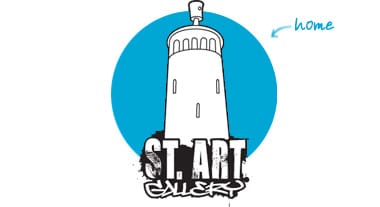Banksy has become arguably the most famous artist of his generation, having risen from humble beginnings as an outsider even in the subculture of graffiti art.
Alongside other visionaries such as Ron English, he is credited with graffiti’s transition from the aerosol abstracts and “bubble writing” favoured in the 1980s to the narrative-driven “street art” of today. Almost unique to Banksy’s street art however are the shrewd use of context, the written word, chutzpah and humour that define graffiti in a historical sense. He is also distinct in his democratic vision, for example favouring the populist mass media as a means of communication rather than the jungle drums of his own niche demographic. Banksy also pioneered the use of alternative venues for the display of street art with his 2003 warehouse exhibition Turf War.
Lazarides founder Steve Lazarides worked with Banksy whilst he was employed as the picture director of the magazine Sleaze Nation, when the title played a tiny part in cultivating the artist’s early career. Steve became Banksy’s de facto agent, a working relationship that ended in early 2009. Banksy’s own organisation Pest Control is now the sole representative of the artist.
Banksy’s “uncommissioned” works – those he has placed without the express permission of the site’s owners – are perhaps his most fondly remembered.
In 2003 Banksy hung the embellished oil painting, Crimewatch UK has Ruined the Countryside for all of Us, a pastoral scene bastardised to include an incident scene sealed off with police tape, in Tate Britain. An official statement explained, “The amount of paranoia and fear about violent crime and paedophilia makes mine a more accurate drawing of the English landscape we actually live in.” It should be noted that the artist was hardly the household name he is now – reporting the incident, The Guardian newspaper described him as “famous for … the cover of the latest Blur album.” The painting was the first example of a number of doctored countryside works displayed in the exhibition Crude Oils; these are now among his most sought-after works.
After the death of Lady Diana Spencer in 2004, Banksy produced a large number of Di-Faced Tenners, counterfeit £10 notes featuring the late Princess of Wales’s image where the ruling monarch’s would normally be. Many were simply given away, including at the Reading music festival. In 2005 Banksy painted various images on Israel’s West Bank Wall, which he described as “the ultimate holiday destination for graffiti artists.” 2006 saw an untitled sculpture of a traditional red British public phone box, seemingly assassinated by an ice pick and abandoned on London’s Soho Square, and a dummy dressed as a Guantanamo Bay prisoner installed alongside Disneyland’s Rocky Mountain Ride. Then, in a 2008 reaction to Britain’s growing ranks of closed circuit television cameras, Banksy painted the slogan “One Nation Under CCTV” in lettering several storeys high on a building in perhaps London’s busiest district, next to a very prominent surveillance camera.
Many of these star turns are immortalised in Banksy’s 2010 film, Exit Through the Gift Shop, which was nominated for an Academy Award for best documentary.


